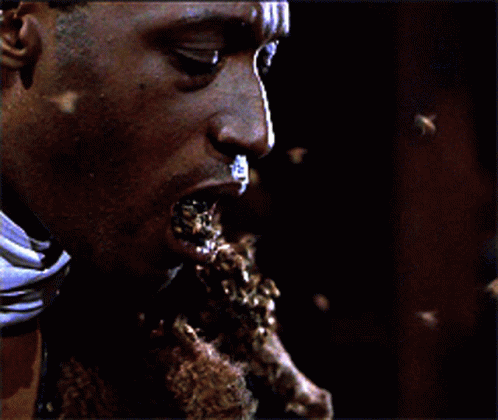And, for the most part, humans’ lungs don’t have bees!
I somehow forgot about bees not having lungs. I knew some other small things didn’t.
Speak for yourself
I find that hard to beelieve
I’m skeptical too, but that’s the buzz.
Most invertebrates have no internal air sac breathing organ. Arachnids kinda do, and I’m seeing something about semi-aquatic snails, but direct diffusion is pretty efficient at that scale.
Axolotls have them despite not needing them because they can live just fine without ever inhaling air for their entire life. But they sometimes do it for fun and then blow out bubbles.
Amphibians are the weirdest vertebrates.
Looking at my axolotl that is currently trying to pretend to be a plant, yep.
What’s that? Human lungs don’t have bees?!
A large influx of bees ought to put a stop to that!
It’s what limits their size. If insects had lungs, they could get larger. 300 million years ago, when the oxygen content in the atmosphere was temporarily higher, there were huge dragonflies with 75 cm wingspan (2.5 ft).
In the original Jurassic Park novel by Michael Crichton, one of the animals they’ve cloned are these giant dragonflies. Its only one line in the book (Tim, one if the kids, sees one fly by and recalls reading about them) but it caught my attention as just straight impossible. I remember thinking, “Unless you’re somehow controlling the oxygen level of the air around this entire island, there’s no way that bug can’t breathe.”
Huh, the Greek hero Spiracles saved the bees
Obviously, the Greek hero Spiracles also rhymes with the bees
TIL
Hunh. TIL.
Not just bees, it’s true of all insects.
Consequently, the amount of oxygen in the air determines how big bugs can grow. Get too big, and the oxygen can’t diffuse into the body fast enough. This even shows up in the fossil records, with larger bugs being found alongside evidence of eras that had more oxygen in the atmosphere.
They aren’t insects, but most arachnids have book lungs, which are basically a pocket full of air gills.
How much was the oxygen and where has it gone since then?
Currently oxygen is about 20% of the atmosphere. In the Carboniferous period, 60 million years ago, it’s thought to have gotten as high as 30%.
Oxygen is highly reactive, and the O2 configuration is not particularly stable, so over time it gets locked up in other molecules, which are then burred or deposited at the bottom of bodies of water.
Oxygen has always been plentiful on earth, but for most of geologic history it was bound up in solid molecules in the crust. Nearly 2.5 billion years ago, bacteria began “unlocking” gaseous O2 as a byproduct of the nitrogen based chemical reaction they lived on.
Hold on, wait a minute, pause. There are people who think that bugs have lungs?
I’m less bothered by that person not knowing and way more bothered by them just being so confidently incorrect. Doesn’t take long to just look it up yourself. Unless the whole post was an educational setup?
To be fair, while bugs and other insects don’t have lungs, some arthropods do. The differences among arthropods, insects and bugs aren’t exactly common knowledge.
some have book-lungs not true lungs. Only us fish have “true” lungs
edit: this thread turned into nerd-heaven. i love it!
Only us fish have “true” lungs

Agreed. I was referring to book lungs.
Also, I feel like you got some ‘splainin’ to do regarding the fish reference.
We’re all descended from fish.
Also, IIRC, some fish are more closely related to us than they are to other fish, making it impossible to biologically define a category of animal that includes everything we call a fish but doesn’t include us.
Thanks!
Also, I recognize your username. I feel like you may have encountered my ignorance on at least one previous occasion.
In a nutshell: speaking cladistically, there is no such thing as a fish, or alternatively, all tetrapods are fish. You cant define a monophyletic group that includes “fish” that doesnt also include humans (and all other tetrapods eg birds and such). That’s my understanding anyway
Fish is a polyphyletic group. It’s a shorthand to refer to various lines of aquatic vertebrates with a similar anatomy. It’s not a clade but that’s not the only way to logically group organisms. People trot it out like a “gotcha” or just misuse it in much the same way they don’t understand speciation (or most science terminology, to be frank)
We are not fish by anyone’s honest definition, but “there’s no such thing as a fish” is the kind of attention-grabbing false revelation I hate: it’s the headline with none of the understanding to actually learn something.
(I’m not annoyed at you, I think you understand perfectly based on your wording)
My knowledge on the subject is purely at a youtube video level so i am happy to have someone else provide better knowledge and insight
I too have seen that Clint’s Reptiles video, lmao
From what I understand, this is sorta like a hangover from pre-DNA taxonomy. We went “yeah, those all look like fish, we’ll put them in the fish group”, only to find out later that a bunch of them weren’t very closely related at all. So now we have a ‘fish’ group that’s a total mess, and we’re in the middle of getting it organized and re-labelled.
Yeah exactly lol science is full of silly stuff like that but that’s the price of knowledge and of using models to understand things. Same with trees and such, they look alike to us so we call a lot of organisms trees but they are VASTLY different from each other in many cases
Can’t we just un-fish it like we do for other clades when we need to?
“There’s an ape in the office!”
“Yes, his name is Tom. More importantly, he is a human being, and we don’t refer to them as apes outside of an academic context and even then, only when necessary.”
[Tom eats a banana, screams at an intern, and starts picking his nose]
No, fuck paraphyletic groups.
I meant, can’t we just be more specific rather than use paraphyletic grouping?
“What’s for dinner?”
“Fish”
“That could mean anything!”
“You know I meant Actinopterygii.”
“Still pretty broad.”
“Oncorhynchus.”
“You know how I feel about trout.”
“Ugh. tshawytscha.”
“Well, why didn’t you just say so in the first place?”
Usually not lungs as they exist in mammals, though.
You’re right. They’re different.
It’s funny that this is biology in 4th grade and half the people here are shocked
I didn’t think bees had lungs. I also didn’t think bees didn’t have lungs…
Insects don’t have lungs. It also means their potential size is directly limited by the oxygen content in the air.
Which is why we don’t see cat sized insects roaming around.
Which is why you don’t see cat sized insects roaming around, I live next to a tarantula trail and some of them fuckers get BIG.
Arachnids are not insects though.
tarantulas do indeed have lungs though
deleted by creator
Yeah they followed paths, I think it’s a way of avoiding dangerous terrain. They are rather fragile beasts.
Spiders aren’t insects. Though like them, they don’t have lungs! Not ones like ours, anyway.
In my defense I am a smartass not smart.
Eh, you were close enough.
Related is this awesome video discussing dinosaur breathing
that was great! thanks!
“fall asleep” sounds like a nice way to say ded
If they “survived the fire” then they probably dont die from oxygen depravation or at least not quickly.
Temporarily “fall asleep” then.
Just let the old ticker get some time off.
Honestly i wouldn’t mind “fall asleep” now.
Sorry but we need you to do your part. Can’t do it without you ;)
Shareholder value isn’t going to increase itself
To bee, or not to bee, that is the question:
Whether 'tis nobler in the mind to suffer
The stings and sparrows of outrageous fortune,
Or to take arms against a sea of troubles,
And by opposing end them: to die, to sleep
No more; and by a sleep, to say we end
The heart-ache, and the thousand natural shocks
That Flesh is heir to? 'Tis a consummation
Devoutly to be wished. To die, to sleep,
To sleep, perchance to Dream; aye, there’s the buzz,
For in that sleep of death, what dreams may come,
When we have fluttered off this mortal coil,
Must give us pause.
Well-done, Hamlet’s ghost Jr! 👏👏👏
Beekeepers intentionally use smoke to make bees docile during collection time, transfers, etc
However, what I’ve heard from a beekeeper is that the smoke triggers a flight response in them (from fire) so they consume honey ready to flee, and that’s actual what makes them docile/drowsy.
You’re telling me the bees get the munchies when they smoke…
Pretty shitty instinct if it means they end up sleeping instead of fleeing.
I think if it comes to it they just flee, drowsily, with full bellies of honey - so they’ve got energy to fly and something left over to start the new hive.
am i the only one who notices that this logic makes no sense? it doesnt matter that they have no lungs, they still are susceptible to both heat and airborn toxins, they perform gas exchange. They lived because the heat and smoke were below lethal toxic levels for them.
this is true,
but the main takeaway is that some people learned that not all animals have or need lungs.
as a kid I assumed insect anatomy was like human but insect shaped, learning how alien they are for the first time is a fascinating experience I wish I could relive.
they are indeed very alien it’s true. And i suppose, i just dont really want people thinking bees are immune to smoke or other airborne toxin.
Another fun fact is that bee flight muscles are directly saturated with oxygen and have a power density comparable to helicopters. The whole bee in flight is comparable to a car. Crazy creatures.
don’t beekeepers use smoke or some such?
Yup. It simulates a forest fire and encourages them to gorge themselves on honey and leave the hive. They get less protective of the hive (because they think it is doomed) which makes it easier to work. They will check back in under an hour to see if the hive made it, and if so, will regurgitate the honey back and continue on with their day.
This sounds strange. You really don’t want to make them abandon the hive. You want to disrupt the hive as little as possible.
My main goal is to not get stung! Also you only go into the hives every few weeks so it’s not a major disruption. Also they only temporarily abandon the hive. They check on it later to see if it made it and then keep on living in it.
For jarred honey with comb in it, how does that affect the hive?
Bee keepers move comb in and out of the hive frequently during the producing seasons. If they just cut the caps (top layer of wax) off the honeycomb, drain it, and then put the comb back in the hive, the bees have to use less energy to make comb, so they make more honey. If you put an “empty frame” (a spot with no honeycomb already on it) it takes the bees a lot more energy to make the comb so there is less honey. So it’s a trade off from the bee keepers’ perspective.
Thanks! TIL.
Never found even harvesting to require more than the occasional puff of smoke. But we had Buckfast, and made sure to replace the queen of any aggressive colony. Maybe you have more aggressive breeds.
Yeah the Russians are a little meaner, but do better with the mites and winter. The Italians are much easier to work, but require a lot more “hand holding”. Either way I normally knock with some smoke at the entrance/through the screened bottom for 2-3 puffs, then when I crack the top or move off a super, add a puff at the location. If I’m working slow and see them start staring me down, they get a little more.
I work bare handed because gloves loose too much dexterity, but that also gives them a giant target.
deleted by creator
Fun additional bee fact! Bee hives have personalities and each hive has a different one! Some hives are very easy going and have no problems being worked. Other hives don’t like to be touched and will get defensive quickly. When working hives, one of the things you look for is bees lining up on the edge of a frame staring you down. If you see that, hit them with some more smoke else you are about to be stung!
Your comment prompted me to recall a great movie, https://en.m.wikipedia.org/wiki/The_Secret_Life_of_Bees_(film)
deleted by creator
Bees navigate using the sun. It doesn’t really seem that they make a map, but more seem to know where they are by the process of directions that got them there. When they return to the hive they just reverse the way they got there. If you stand in front of the entrance to a bee hive for a few minutes then turn around to face away from the hive, you will see a swarm of bees flying in a holding pattern waiting for you to move so they can return. Once you move the entrance to the hive gets really busy. They don’t seem to know to go around you, they just wait till the path is clear!
deleted by creator
Here’s another for the road: mites are a big problem for bees. They latch on to the bees and the bees don’t feel them. One way bee keepers can encourage bees to clean themselves and knock off the mites is by covering the bees in powdered sugar! This makes it look like there are a bunch of powder white bees flying around for a while.
They stay in the hive if it’s not hot iirc
Yup, if it’s cold they stay inside the hive and ball up! They vibrate against each other to make heat and stay warm.
Yea tobacco smoke I think but want to say they were being stopped for that n9t sure.
I don’t believe they’d use tobacco, as nicotine is especially toxic to insects (and has a long history of being used as an insecticide).
Beekeepers burn paper, woodchips, or really anything that burns well that they have on hand (that isn’t toxic). Source: Have used smoker while handling beehives.
That makes sense after reading up more I believe I’m wrong I feel like I’d heard that they used nicotine and hadn’t fully researched and took it at face value. Thabks for the information!!
Looking around there does seem to be people who use tobacco. I guess poisoning the bees probably makes them more docile 😅 Still a bad idea though
Muh profitsis probably.
I remember the first time I heard bugs dont have lungs. Like wtf? Just no internal ventilation pumping air as needed. Seems wierd but also thx God. They are annoying enough.
They also have no blood or blood vessels, just a little heart and blood-like stuff splashing around.
I didn’t know that either wow. Really freaking and interesting
Bugs are fucking weird.
Well that’s a Christmas spiracle
Just laughed aloud in a café, thanks for that
Next they’re going to tell me that bees don’t have hearts
they actually do, they have a “blood” vessel they use to transfer nutrients back and forth their bodies, no need for oxygen distribution though.
But that’s illegal!
You wouldn’t not have a car.
You wouldn’t not have a handbag.
You wouldn’t not have a television.
You wouldn’t not have lungs.
Lacking lungs is not having them.
Not having lungs is against the law.
Lunglessness, it’s a crime.
Arrest Neelix!
Lungs, not even once.
Just say anything because doing so proves you have lungs to power your larynx.
I only communicate through stridulation
And not a dance like the noble bee?
Only when someone asks me for directions
insects are also all upside-down
















